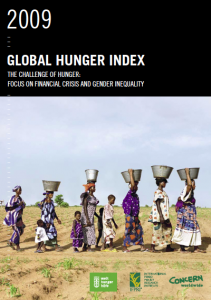Resource Title
2009 Global Hunger Index: focus on financial crisis and gender inequality
Summary
Now in its 4th edition, the Global Hunger Index has become the standard for tracking trends in the comparative levels of hunger in different parts of the world and across individual nations.
Organised annually by a leading theme, the report is designed for policymakers, antipoverty workers and advocates and is driven by two factors: the need for information (on how and why hunger is occurring) and the need for action (addressing the short, medium and long term causes of hunger).
Because developing countries are more integrated within world markets through trade, investment flows, and remittances than in the past, the latest food and financial crises have stronger effects on those countries than during previous crises. The impact is also stronger on the poor and hungry, many of whom are now more closely linked to the wider economy, which this report explore.
An important part of the solution to global hunger is reducing gender inequality. This report compares the 2009 GHI with the 2008 Global Gender Gap Index, which is made up of four subindices: economic participation, educational attainment, political empowerment, and health and survival. The evidence shows that higher levels of hunger are associated with lower literacy rates and access to education for women. High rates of hunger are also linked to health and survival inequalities between men and women. Reducing gender disparities in key areas, particularly in education and health, is thus essential to reduce levels of hunger.
Resource Details
Description
Available from:
- Download 2009 Global Hunger Index PDF
- Download 2009 GHI briefing paper PDF
- The raw data, an overlaid map and other information relating to the 2010 report are available on the IFPRI website

